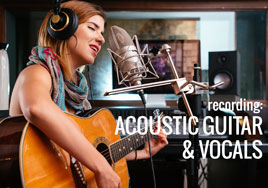Recording Acoustic Guitar & Vocals
By Estimated reading time: 5 minutesHello again, fellow musicians!
In today’s article, I wanted to tackle recording acoustic guitar with vocals and choosing the right microphones.
Recording Guitar with Vocals—How Many Mics?
A lot of you are probably wondering, “How many mics should I use when recording my guitar with vocals?” Well… it all depends on what type of sound you want.
It’s not uncommon for a modern recording session to have a mic (or several) or direct input for each instrument or vocalist, with each mic/input feeding into a unique audio track in the recording software. This allows the audio engineer to isolate sounds and control them individually.
But, just because it’s common practice doesn’t mean it’s the only way (or even the best way). Before multitracking, using a single mic to record a guitar and vocals was very common. As unusual as it might be today, some of your favorite bands of the past used only 1 or 2 mics to record the whole band, from drums to vocalists. Mics were selected, all the instruments and vocalists were positioned strategically, the engineer pressed record on their 4 track tape machine, and a record was made.
As I said above, the right number of mics for your project depends on the sound you want. To get the right results, though, it’s important to use the right mic and to position it correctly. Keep reading for more details.
Choosing the Right Type of Microphone
Dynamic Mics
Dynamic mics are considered your typical stage mic. Most concert venues, churches, and so on use dynamic mics because they can handle high pressure sound levels, and they are used when the sound source is close and loud. The most popular dynamic mics are Shure SM58, SM57, and SM7B.

PROs: These mics are fairly inexpensive, rugged, and road-worthy. The sound is pure and focused. They do not require phantom power (48v).
CONs: These mics can produce a nasal sound. They lack some high end (in comparison to condenser mics). They also have a pronounced proximity effect (the closer your source is to the mic, the more enhanced the bass sounds), so some EQ tweaking may be needed depending on the sound you are after.
Condenser Mics
Condenser microphones are the most common types of microphones you’ll find in recording studios. They have a much greater frequency response and transient response (which is the ability to reproduce the “speed” of an instrument or voice). They also generally have a louder output but are much more sensitive to loud sounds.
PROs: Much greater frequency and transient response. A louder output.
CONs: Often more expensive than dynamic mics. They can be very brittle with little low end. They require phantom power (48v). They are very sensitive to loud sounds and may require a pop filter for plosives ‘p’ sounds.
Different Types of Condenser Mics:
Large Diaphragm Microphones – Large diaphragm microphones (LDMs) are generally the choice for studio vocals and any instrument recording where a “deep” sound is desired. A large diaphragm microphone generally warms up the sound of what it’s recording. If using a condenser microphone for vocals, you’ll likely want to use a pop screen; these mics are so sensitive to transient noises that the “P” and “SH” sounds you make will cause distortion.
Small Diaphragm Microphones – Small diaphragm microphones (SDMs) are generally the best choice where you want a solid, wide frequency response and the best transient response, which, as we mentioned before, is the ability for your microphone to reproduce fast sounds (such as stringed instruments).
Good condenser microphones include the Audio Technica 2035, Oktava MC012 ($99), RODE NT1 ($199), and AKG C414B ($700)

Once you have decided on the type of mic you are going to use, let’s go over mic positioning.
Mic Positioning
Recording Guitar and Vocals With One Microphone
Try to position the mic far enough away to capture the voice and guitar, but not so far that you capture the room sound. This is going to take some testing of various mic positions for the sound you want. Again, use your ears for best judgment.
As important as proper placement is, it’s even more important to use a mic with the right pattern. A cardiod mic in this scenario may work well because they reject sound from the rear. On the other hand, omni mics have a figure 8 pattern, which means they pick up sound from the front and rear of the capsule.
Recording Guitar and Vocals With Two Mics
If you’re using a large‑diaphragm condenser, you can achieve a useful improvement in the amount of separation by switching from cardioid pattern (where the null is behind the mic) to figure‑8 (where the null is perpendicular to the plane of the mic, and much deeper than in cardioid). How does this help? Using a figure 8 pattern or omni mic means that the null point will cancel the other mic out of its pickup. You may still have some spill, but you won’t have as much of a phasing nightmare.
Microphone Applications
Acoustic Guitar
A small diaphragm cardioid condenser is preferable here. As a starting point, aim it down so it’s looking at the 12th fret, and set it about 6-8 inches away.
Large diaphragm condensers can also work nicely on acoustic guitars, as well as ribbon mics. Have fun experimenting with different mics and placements to find what works best for you.
Vocals
When it comes time to overdub vocals, you’ll want a large diaphragm condenser mic. For a lead vocal, you should match the mic to the vocalist, who may have a personal mic preference.
As you can see, there are different techniques for different mics for different applications. There really is no standard setup. As I always tell musicians and engineers, use your ears to find out which mic and setup produces the sound you want.
Leave a comment
...Keep Reading














